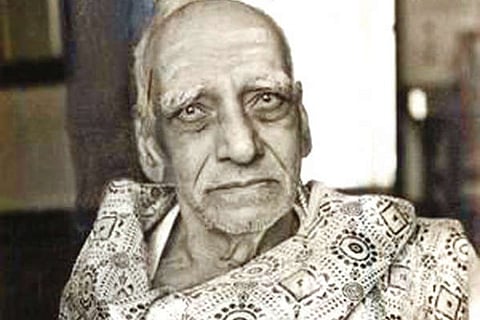

Chennai
There was a music-loving lawyer who lived in a petite tiled house in Nadu Street of Mylapore. So much a lover of Carnatic music was Sundaram Iyer, that he built a performance hall on his first floor to hold chamber concerts for the pleasure of his family and friends. Sundaram learnt of an impoverished poet who also set his songs to tune and had migrated to Madras in search of a fortune from Tanjore. Sundaram Iyer decided to be the patron of the indigent poet.
Papanasam Sivan had nothing to do with either of his names. Polagam Rama Sharma (Ramaiyya) was his actual name and singing Shiva songs in the Papanasam temple got him this different nomenclature. Sundaram would allow Sivan to stay with him and instruct music to his children. The in-house training worked. One of them became a renowned veena player, one a famed musicologist and one a film heroine. As much as it changed the lives of his students, Sivan’s music tutoring stint would change his own life as well.
Orphaned very early, Sivan as a young boy would listen to bhajans and musical discourses which ignited the spark for music. A move from Thiruvananthapuram (where he studied on a scholarship from the maharaja) to Tanjore, then the seat of Carnatic revivalism added to his passion. It was then that he realised not only could he appreciate Carnatic music but that he possessed a musical streak within him and he could compose songs and set tunes. Surprising, he did not have any formal training in either Tamil or music. His talent was a combination of hearsay and genius. As Madras was becoming the magnet for performing arts, Sivan would move there.
The great director Shantaram had mislaid a fortune making a Marathi mythological and wanted to make a Tamil talkie using the same sets to recoup a part of the lost money. He identified Seethaswayamvaram as a satisfactory story and with his limited contacts in Madras, settled on lawyer Sundaram’s family as the main cast. The lawyer’s son was the hero and his daughter the heroine while he himself played Dasaratha. When the question arose on the lyricist and music director, the tuition teacher was roped in.
Sivan stepped into the world which would give the greatest reach for his songs and tunes. There was no pre-recording of songs, and while the actor sang, orchestra players were seated on a trolley outside the view of the camera. But Sivan’s unassuming lyrics and unpretentious tunes caught the interest of the newfound talkie audiences. The success of the early talkies propelled more viewers to the tent kottagais (thatched roof cinema halls) and producers laughed all the way to their banks and music directors were in great demand.
He would also act in some of the movies. Director K Subrahmanyam cast him in the role of Shambu Sastri in the landmark film Tyaga Bhoomi, based on Kalki Krishnamurthy’s story. In another movie he acted as poverty-stricken Kuchela, a role people joked he required no makeup. When early talkies ran only on the power of songs, Papanasam Sivan composed songs that created superstars like MK Thyagaraja Bagavathar and MS Subbulakshmi. But the true artist he was, Sivan seldom made much money for all this and would remain impoverished for life.
Sivan remains the person who laid the foundation for Tamil cinema music and lyrics. Sivan wrote more than 800 songs for over 70 films, once even penning and tuning 50 songs for MKT’s Pavalakodi (a record still not broken). Some of his songs like manmatha leelaiyai venraar undo? (has anyone won the games of cupid?) are still popular.
After his initial popularity, he was associated with Rukmani Devi who gave much importance to background music and even seated the musicians on stage in her new form of the sanitised Sathir (an ancient dance form). Sivan understood the concept of dance so well that most of his ‘krithis’ were stage-ready to accompany the dancer.
While Papanasam Sivan may have been a composer with the widest reach while he lived as the new form of vehicle cinema taking music to nooks and corners, unknowingly he may have been responsible for brewing a socio-cultural revolution.
Carnatic music till then was wholly Telugu and Sanskrit songs, mostly penned by the trinity. The mighty sabhas ensured that the corpus of songs sung on their premises remains unchanged. Sivan’s compositions nullified the traditional music lobby’s assertion that Tamil was not a good language to compose Carnatic music and that there were not enough songs in its corpus.
Almost 200 of his songs had seeped into the Tamil tastes from 1935 in the voices of MKT, MS and Dandapani Desikar. The film songs, also based on Carnatic music, soon increased the interest in audiences to listen to simpler songs in their native tongue. Suddenly there cropped up a demand for Tamil songs to be sung in sabhas as well. This snowballed into a huge dispute over ten years and the traditional and Tamil sabhas fought an acrimonious battle.
But Sivan’s passion was bhajans. And especially the ones sung while circumambulating temples in the chill misty marghazhi mornings (He did it around Kapali temple for half a century even in his frail end years).
Sivan produced a huge volume of compositions almost equal to Tyagaraja, but in Tamil and structured in simply constituted compositions. They found great welcome on the concert platforms soon. To bring Tamil music to the fore was a Herculean task and Papanasam Sivan came to be known as ‘Tamil Tyagaraja’.
— The writer is a historianand an author
(Photos and inputs: Ashok Ramani)
Visit news.dtnext.in to explore our interactive epaper!
Download the DT Next app for more exciting features!
Click here for iOS
Click here for Android